2017-06-15 - Nº 111
Editorial
Esta é a Newsletter Nº 111 que se apresenta com o mesmo formato que as anteriores. Se gostar da Newsletter partilhe-a!
Todas as Newsletters encontram-se indexadas no link.
Esta Newsletter tem os seguintes tópicos:
Faz hoje anos que nascia, em 1916, Herbert A. Simon. Este norte-americano ficou conhecido por ser um dos pioneiros de vários dos importantes domínios científicos actuais, incluindo a inteligência artificial, o processamento de informação, a tomada de decisão, a resolução de problemas, a teoria organizacional, os sistemas complexos e simulação computacional de descobertas científicas. Ele criou os termos racionalidade delimitada e satisfatória, e foi o primeiro a analisar a arquitectura da complexidade e de propor um mecanismo de associação preferencial para explicar as distribuições da lei do poder. Também faz anos hoje que nascia em 1755, Antoine François, comte de Fourcroy. Este químico francês ficou conhecido pela co-descoberta do Irídio. Juntamente com Lavoisier, Guyton de Morveau, e Claude Berthollet foi também um dos responsáveis pela estandardização da nomenclatura química actual.
Nas noticias da semana, a Boeing estuda a possibilidade de construir aviões comerciais de passageiros que voem sem piloto, usando a inteligência artificial que guia os controlos para tomar as decisões de voo. investigadores da Microsoft criaram um sistema baseado em inteligência artificial que aprendeu a obter a pontuação máxima no jogo de video da década de 1980 Ms. Pac-Man, usando um método de divisão e conquista que poderá ter amplas implicações para o ensino de agentes de AI fazer tarefas complexas que aumentam as capacidades humanas. A equipa de Maluuba, uma empresa canadiana de "deep learning" adquirida pela Microsoft no início deste ano, usou um ramo da AI chamado "reinforcement learning" para jogar de forma perfeita a versão Atari 2600 do Ms. Pac-Man. A GloabalFoundries anunciou a disponibilidade da sua tecnologia de semicondutores de 7nm - Leading-Performance (7LP) FinFET. Esta fornece um aumento de desempenho de 40 por cento para responder às necessidades de aplicações, como processadores móveis de topo, servidores em cloud e infraestruturas de rede. Foi anunciado esta semana que o planeta Júpiter tem agora 69 luas conhecidas. O planeta Júpiter é gigante: trezentas e dezassete vezes a massa da Terra, principalmente feita de hidrogénio metálico, e no centro de um colectivo surpreendente de corpos naturais em órbita. Foram os astrónomos Scott Sheppard, David Tholen e Chadwick Trujillo que fizeram a descoberta das duas novas luas. Estas novas luas têm cerca de 1-2 km de tamanho, e foram vistas em imagens que faziam parte de uma pesquisa para objectos muito mais distantes na Cintura de Edgeworth-Kuiper.
Na Newsletter desta semana apresentamos diversos projetos de maker assim como alguns modelos 3D que poderão ser úteis. É apresentada também a revista newelectronics de 13 de Junho.
 João Alves ([email protected])
João Alves ([email protected])
O conteúdo da Newsletter encontra-se sob a licença  Creative Commons Attribution-NonCommercial-ShareAlike 4.0 International License.
Creative Commons Attribution-NonCommercial-ShareAlike 4.0 International License.
Novidades da Semana

Boeing studies planes without pilots, plans experiments next year
"Boeing has begun researching the possibility of commercial-passenger jets that will fly without pilots, using artificial intelligence guiding automated controls to make decisions in flight. “The basic building blocks of the technology are clearly available,” said Mike Sinnett, former chief systems engineer on the 787 Dreamliner and now vice president at Boeing responsible for innovative future technologies, at a briefing before the Paris Air Show. “There’s going to be a transition from the requirement to have a skilled aviator operate the airplane to having a system that operates the vehicle autonomously, if we can do that with the same level of safety,” Sinnett said. “That’s a really big if,” he added. It sure is. Think about a machine that could do what US Airways Capt. Chesley Sullenberger did in New York City in 2009. When a flock of geese took out both engines on an Airbus A320 with 155 people on board as it took off out of La Guardia, Sullenberger communicated with ground controllers, rapidly sized up his limited options within two minutes and guided the plane to a safe ditching in the Hudson River. Sinnett, who plans a June 21 presentation on the subject at the Paris Air Show, agreed that the Sullenberger scenario is the standard that has to be achieved. It also underscores the challenge Boeing faces in attempting to take the human out of the flight deck." [...]
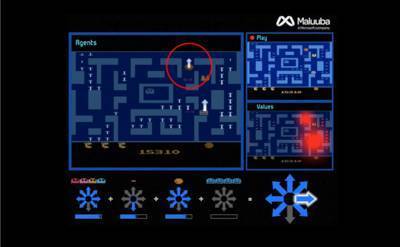
Divide and conquer: How Microsoft researchers used AI to master Ms. Pac-Man
"Microsoft researchers have created an artificial intelligence-based system that learned how to get the maximum score on the addictive 1980s video game Ms. Pac-Man, using a divide-and-conquer method that could have broad implications for teaching AI agents to do complex tasks that augment human capabilities. The team from Maluuba, a Canadian deep learning startup acquired by Microsoft earlier this year, used a branch of AI called reinforcement learning to play the Atari 2600 version of Ms. Pac-Man perfectly. Using that method, the team achieved the maximum score possible of 999,990. Doina Precup, an associate professor of computer science at McGill University in Montreal said that’s a significant achievement among AI researchers, who have been using various videogames to test their systems but have found Ms. Pac-Man among the most difficult to crack. But Precup said she was impressed not just with what the researchers achieved but with how they achieved it. To get the high score, the team divided the large problem of mastering Ms. Pac-Man into small pieces, which they then distributed among AI agents." [...]
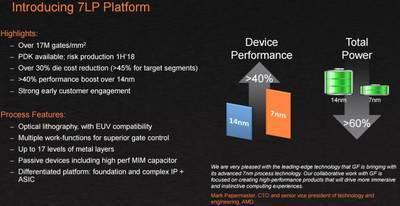
GLOBALFOUNDRIES on Track to Deliver Leading-Performance 7nm FinFET Technology
"GLOBALFOUNDRIES today announced the availability of its 7nm Leading-Performance (7LP) FinFET semiconductor technology, delivering a 40 percent generational performance boost to meet the needs of applications such as premium mobile processors, cloud servers and networking infrastructure. Design kits are available now, and the first customer products based on 7LP are expected to launch in the first half of 2018, with volume production ramping in the second half of 2018. In September 2016, GF announced plans to develop its own 7nm FinFET technology leveraging the company’s unmatched heritage of manufacturing high-performance chips. Thanks to additional improvements at both the transistor and process levels, the 7LP technology is exceeding initial performance targets and expected to deliver greater than 40 percent more processing power and twice the area scaling than the previous 14nm FinFET technology. The technology is now ready for customer designs at the company’s leading-edge Fab 8 facility in Saratoga County, N.Y. “Our 7nm FinFET technology development is on track and we are seeing strong customer traction, with multiple product tapeouts planned in 2018,” said Gregg Bartlett, senior vice president of the CMOS Business Unit at GF. “And, while driving to commercialize 7nm, we are actively developing next-generation technologies at 5nm and beyond to ensure our customers have access to a world-class roadmap at the leading edge.”" [...]

Michelin Visionary Concept
"To which we could add: pleasanter, more accessible, more practical, more connected and so on. For over a century, this business purpose of ours has led us to bring to market innovations that improve mobility. It also compels us to constantly project ourselves into the future so that we can imagine what mobility of the future might look like! Imagine a future in which your tire is also a wheel: puncture-proof because there is no pressure. Its ruggedness comes from its biomimetic structure, as if it had been created by Nature... A wheel made of recycled materials and which is completely recycled at the end of its life, after having covered thousands and thousands of kilometers - as long as the vehicle itself. Now imagine that you don't have to worry any more about keeping your loved ones safe when you travel, because road conditions and bad weather don't matter any more: your tread instantly adjusts to your driving conditions, whenever necessary, using just the right amount of materials. A tread that can be modified and replenished at will, without wasting any resources, time or money, and which protects the environment for the generations to come... This mobility solution... Michelin has imagined it. And even a bit more than that: the prototype of the MICHELIN Visionary Concept unveiled on the Michelin stand at Movin'On in Montreal (June 13 to 15) sparked intense curiosity among experts and the international press." [...]

Jupiter Now Has 69 Moons
"Our local gas giant has two more natural satellites added to its roster. The planet Jupiter is a beast: Three-hundred-and-seventeen times the mass of the Earth, mostly made of metallic hydrogen, and at the center of an astonishing collective of orbiting natural bodies. In fact, Jupiter's satellites form a shrunken version of a full planetary system: from the tightly bound larger Galilean moons (orbiting in their Laplacian mean-motion resonances, akin to places like TRAPPIST-1) to the remarkable array of smaller moonlets that encircle this world out to more than 30 million kilometers. These bodies circle Jupiter in anywhere from about 7 hours to an astonishing 1,000 days. Until recently the cataloged satellites totaled 67 in number. But only the innermost 15 of these orbit Jupiter in a prograde sense (in the direction of the planet's spin). The rest are retrograde, and are likely captured objects - other pieces of the solar system's solid inventory that strayed into Jupiter's gravitational grasp." [...]
Outras Notícias
- Microchip Extends eXtreme Low Power PIC32MM Microcontroller Family
- Surface-Mount Intelligent Low-Power Modules from STMicroelectronics Save Space in Energy-Efficient Motor Drives
- GLOBALFOUNDRIES Launches 7nm ASIC Platform for Data Center, Machine Learning, and 5G Networks
- Microsemi Announces SoftConsole v5.1, the World's First Freely Available Windows-Hosted Eclipse Integrated Development Environment Supporting RISC-V Open Instruction Set Architecture
- IBM Integrates with BMW CarData to Enable New and Innovative Services for Drivers
- Samsung Achieves 220 Lumens per Watt with New Mid-Power LED Package
- PCI-SIG Publishes PCI Express 4.0, Revision 0.9 Specification
Ciência e Tecnologia

AgeLab researching autonomous vehicle systems in ongoing collaboration with Toyota
"The MIT AgeLab will build and analyze new deep-learning-based perception and motion planning technologies for automated vehicles in partnership with the Toyota Collaborative Safety Research Center (CSRC). The new research initiative, called CSRC Next, is part of a five-year-old ongoing relationship with Toyota. The first phase of projects with Toyota CSRC has been led by Bryan Reimer, a research scientist at MIT AgeLab, which is part of the MIT Center for Transportation and Logistics. Reimer manages a multidisciplinary team of researchers, and students focused on understanding how drivers respond to the increasing complexity of the modern operating environment. He and his team studied the demands of modern in-vehicle voice interfaces and found that they draw drivers’ eyes away from the road to a greater degree than expected, and that the demands of these interfaces need to be considered in the time course optimization of systems. Reimer’s study eventually contributed to the redesign of the instrumentation of the current Toyota Corolla and the forthcoming 2018 Toyota Camry. (Read more in the 2017 Toyota CSRC report.) Reimer and his team are also building and developing prototypes of hardware and software systems that can be integrated into cars in order to detect everything about the state of the driver and the external environment. These prototypes are designed to work both with cars with minimal levels of autonomy and with cars that are fully autonomous. Computer scientist and team member Lex Fridman is leading a group of seven computer engineers who are working on computer vision, deep learning, and planning algorithms for semi-autonomous vehicles. The application of deep learning is being used for understanding both the world around the car and human behavior inside it." [...]
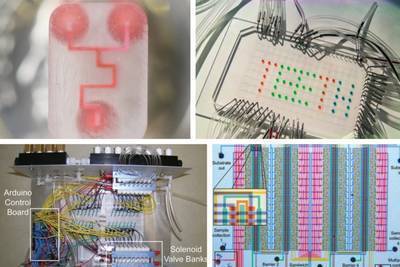
Microfluidics for the masses
"A new MIT-designed open-source website might well be the Pinterest of microfluidics. The site, Metafluidics.org, is a free repository of designs for lab-on-a-chip devices, submitted by all sorts of inventors, including trained scientists and engineers, hobbyists, students, and amateur makers. Users can browse the site for devices ranging from simple cell sorters and fluid mixers, to more complex chips that analyze ocular fluid and synthesize gene sequences. The site also serves as a social platform for the microfluidics community: Any user can log in to submit a design; they can also like, comment on, and download design files to reproduce a featured device or improve on it. David S. Kong, director of the MIT Media Lab’s new Community Biotechnology Initiative, says the new site is designed to accelerate innovation in microfluidic design, which until now has followed a conventional, academically peer-reviewed route." [...]
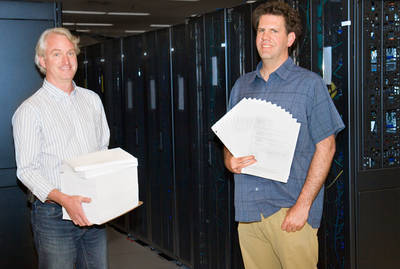
‘Charliecloud’ simplifies Big Data supercomputing
"At Los Alamos National Laboratory, home to more than 100 supercomputers since the dawn of the computing era, elegance and simplicity of programming are highly valued but not always achieved. In the case of a new product, dubbed “Charliecloud,” a crisp 800-line code helps supercomputer users operate in the high-performance world of Big Data without burdening computer center staff with the peculiarities of their particular software needs. “Charliecloud lets users easily run crazy new things on our supercomputers,” said lead developer Reid Priedhorsky of the High Performance Computing Division at Los Alamos. “Los Alamos has lots of supercomputing power, and we do lots of simulations that are well supported here. But we’ve found that Big Data analysis projects need to use different frameworks, which often have dependencies that differ from what we have already on the supercomputer. So, we’ve developed a lightweight ‘container’ approach that lets users package their own user defined software stack in isolation from the host operating system.”" [...]
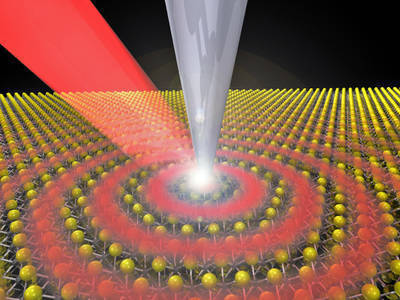
Researchers image quasiparticles that could lead to faster circuits, higher bandwidths
"Zhe Fei pointed to the bright and dark vertical lines running across his computer screen. This nano-image, he explained, shows the waves associated with a half-light, half-matter quasiparticle moving inside a semiconductor. “These are waves just like water waves,” said Fei, an Iowa State University assistant professor of physics and astronomy and an associate of the U.S. Department of Energy’s Ames Laboratory. “It’s like dropping a rock on the surface of water and seeing waves. But these waves are exciton-polaritons.” Exciton-polaritons are a combination of light and matter. Like all quasiparticles, they’re created within a solid and have physical properties such as energy and momentum. In this study, they were launched by shining a laser on the sharp tip of a nano-imaging system aimed at a thin flake of molybdenum diselenide (MoSe2), a layered semiconductor that supports excitons. Excitons can form when light is absorbed by a semiconductor. When excitons couple strongly with photons, they create exciton-polaritons. It’s the first time researchers have made real-space images of exciton-polaritons. Fei said past research projects have used spectroscopic studies to record exciton-polaritons as resonance peaks or dips in optical spectra. Until recent years, most studies have only observed the quasiparticles at extremely cold temperatures – down to about -450 degrees Fahrenheit. But Fei and his research group worked at room temperature with the scanning near-field optical microscope in his campus lab to take nano-optical images of the quasiparticles." [...]
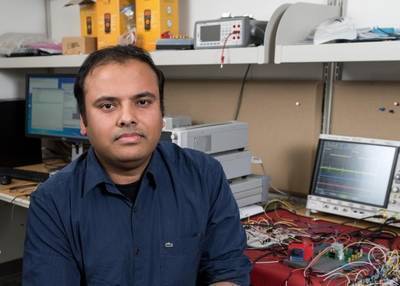
New Computing System Takes Its Cues from Human Brain
"Some problems are so challenging to solve that even the most advanced computers need weeks, not seconds, to process them. Now a team of researchers at Georgia Institute of Technology and University of Notre Dame has created a new computing system that aims to tackle one of computing’s hardest problems in a fraction of the time. “We wanted to find a way to solve a problem without using the normal binary representations that have been the backbone of computing for decades,” said Arijit Raychowdhury, an associate professor in Georgia Tech’s School of Electrical and Computer Engineering. Their new system employs a network of electronic oscillators to solve graph coloring tasks – a type of problem that tends to choke modern computers. Details of the study were published April 19 in the journal Scientific Reports. The research was conducted with support from the National Science Foundation, the Office of Naval Research, the Semiconductor Research Corporation and the Center for Low Energy Systems Technology." [...]
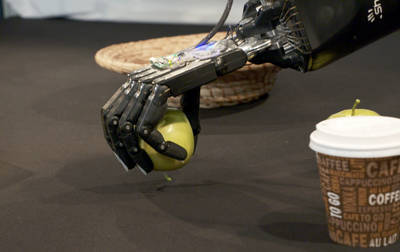
Self-Learning Robot Hands
"Researchers at Bielefeld University have developed a grasp system with robot hands that autonomously familiarizes itself with novel objects. The new system works without previously knowing the characteristics of objects, such as pieces of fruit or tools. It was developed as part of the large-scale research project Famula at Bielefeld University’s Cluster of Excellence Cognitive Interaction Technology (CITEC). The knowledge gained from this project could contribute to future service robots, for instance, that are able to independently adapt to working in new households. CITEC has invested approximately one million Euro in Famula. In a new “research_tv” report from Bielefeld University, the coordinators of the Famula project explain the new innovation. “Our system learns by trying out and exploring on its own – just as babies approach new objects,” says neuroinformatics Professor Dr. Helge Ritter, who heads the Famula project together with sports scientist and cognitive psychologist Professor Dr. Thomas Schack and robotics Privatdozent Dr. Sven Wachsmuth. The CITEC researchers are working on a robot with two hands that are based on human hands in terms of both shape and mobility. The robot brain for these hands has to learn how everyday objects like pieces of fruit, dishes, or stuffed animals can be distinguished on the basis of their color or shape, as well as what matters when attempting to grasp the object." [...]

New system allows optical “deep learning”
"“Deep learning” computer systems, based on artificial neural networks that mimic the way the brain learns from an accumulation of examples, have become a hot topic in computer science. In addition to enabling technologies such as face- and voice-recognition software, these systems could scour vast amounts of medical data to find patterns that could be useful diagnostically, or scan chemical formulas for possible new pharmaceuticals. But the computations these systems must carry out are highly complex and demanding, even for the most powerful computers. Now, a team of researchers at MIT and elsewhere has developed a new approach to such computations, using light instead of electricity, which they say could vastly improve the speed and efficiency of certain deep learning computations. Their results appear today in the journal Nature Photonics in a paper by MIT postdoc Yichen Shen, graduate student Nicholas Harris, professors Marin Soljačić and Dirk Englund, and eight others. Soljačić says that many researchers over the years have made claims about optics-based computers, but that “people dramatically over-promised, and it backfired.” While many proposed uses of such photonic computers turned out not to be practical, a light-based neural-network system developed by this team “may be applicable for deep-learning for some applications,” he says. Traditional computer architectures are not very efficient when it comes to the kinds of calculations needed for certain important neural-network tasks. Such tasks typically involve repeated multiplications of matrices, which can be very computationally intensive in conventional CPU or GPU chips." [...]

From drinking straws to robots
"At the beginning of the decade, George Whitesides helped rewrite the rules of what a machine could be with the development of biologically inspired “soft robots.” Now he’s poised to rewrite them again, with help from some plastic drinking straws. Inspired by arthropod insects and spiders, Whitesides and Alex Nemiroski, a former postdoctoral fellow in Whitesides’ Harvard lab, have created a type of semi-soft robot capable of standing and walking. The team also created a robotic water strider capable of pushing itself along the liquid surface. The robots are described in a recently published paper in the journal Soft Robotics. Unlike earlier generations of soft robots, which could stand and awkwardly walk by inflating air chambers in their bodies, the new robots are designed to be far nimbler. Though real-world applications are still far off, the researchers hope the robots eventually could be used in search operations following natural disasters or in conflict zones." [...]
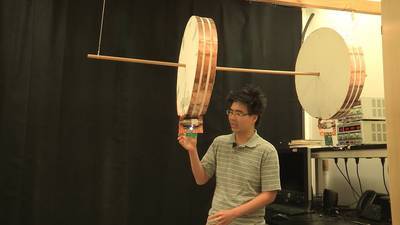
Wireless charging of moving electric vehicles overcomes major hurdle in new Stanford research
"If electric cars could recharge while driving down a highway, it would virtually eliminate concerns about their range and lower their cost, perhaps making electricity the standard fuel for vehicles. Now Stanford University scientists have overcome a major hurdle to such a future by wirelessly transmitting electricity to a nearby moving object. Their results are published in the June 15 edition of Nature. “In addition to advancing the wireless charging of vehicles and personal devices like cellphones, our new technology may untether robotics in manufacturing, which also are on the move,” said Shanhui Fan, a professor of electrical engineering and senior author of the study. “We still need to significantly increase the amount of electricity being transferred to charge electric cars, but we may not need to push the distance too much more.” The group built on existing technology developed in 2007 at MIT for transmitting electricity wirelessly over a distance of a few feet to a stationary object. In the new work, the team transmitted electricity wirelessly to a moving LED lightbulb. That demonstration only involved a 1-milliwatt charge, whereas electric cars often require tens of kilowatts to operate. The team is now working on greatly increasing the amount of electricity that can be transferred, and tweaking the system to extend the transfer distance and improve efficiency." [...]

Researchers Discover Short-Cut to Satellite-Based Quantum Encryption Network
"In a new study, researchers demonstrate ground-based measurements of quantum states sent by a laser aboard a satellite 38,000 kilometers above Earth. This is the first time that quantum states have been measured so carefully from so far away. “We were quite surprised by how well the quantum states survived traveling through the atmospheric turbulence to a ground station,” said Christoph Marquardt from the Max Planck Institute for the Science of Light, Germany. “The paper demonstrates that technology on satellites, already space-proof against severe environmental tests, can be used to achieve quantum-limited measurements, thus making a satellite quantum communication network possible. This greatly cuts down on development time, meaning it could be possible to have such a system as soon as five years from now.” A satellite-based quantum-based encryption network would provide an extremely secure way to encrypt data sent over long distances. Developing such a system in just five years is an extremely fast timeline since most satellites require around 10 years of development. Normally, every component — from computers to screws — must be tested and approved to work in the harsh environmental conditions of space and must survive the gravitational changes experienced during the launch. Marquardt and his colleagues from the division of Gerd Leuchs at the Max Planck Institute in Erlangen report their new research in Optica, The Optical Society's journal for high impact research." [...]
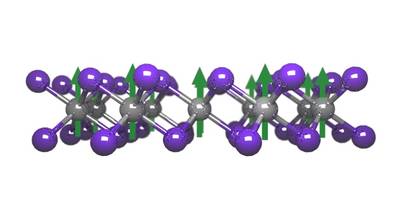
Scientists discover a 2-D magnet
"Magnetic materials form the basis of technologies that play increasingly pivotal roles in our lives today, including sensing and hard-disk data storage. But as our innovative dreams conjure wishes for ever-smaller and faster devices, researchers are seeking new magnetic materials that are more compact, more efficient and can be controlled using precise, reliable methods. A team led by the University of Washington and the Massachusetts Institute of Technology has for the first time discovered magnetism in the 2-D world of monolayers, or materials that are formed by a single atomic layer. The findings, published June 8 in the journal Nature, demonstrate that magnetic properties can exist even in the 2-D realm — opening a world of potential applications." [...]
Modelos 3D
Com a disponibilidade de ferramentas que permitem dar azo a nossa imaginação na criação de peças 3D e espaços como o thingiverse para as publicar, esta rubrica apresenta alguns modelos selecionados que poderão ser úteis.

Peg board round cable holder
"A pegboard holder for electronic test leads and cables. This cable holder fits to the standard 1 inch spaced pegboards. The OpenSCAD file is included in case you want to modify the design." [...]
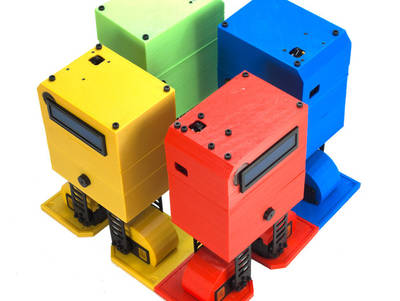
Chip-E - RobotGeek Biped
"Chip-E is RobotGeek’s first 3D printable robot kit that you can build yourself! Powered by the RGS-13 servos and the RobotGeek Geekduino and Sensor Shield components Chip-E is a cute and lovable walking companion that you can print at home, with a friend or through a printing service. Open source design and programming allow you to expand its abilities and truly make your Chip-E unique!" [...]
Documentação
A documentação é parte essencial do processo de aprendizagem e a Internet além de artigos interessantes de explorar também tem alguma documentação em formato PDF interessante de ler. Todos os links aqui apresentados são para conteúdo disponibilizado livremente pelo editor do livro.
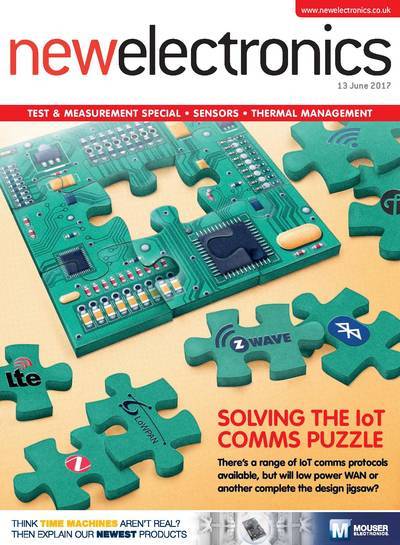
newelectronics de 13 de Junho 2017
"New Electronics is a fortnightly magazine focusing on technological innovation, news and the latest developments in the electronics sector. Downloadable as a digital page turner or pdf file, or offered as a hard copy, the New Electronics magazine is available in a format to suit you." [...]
Projetos Maker
Diversos Projetos interessantes.
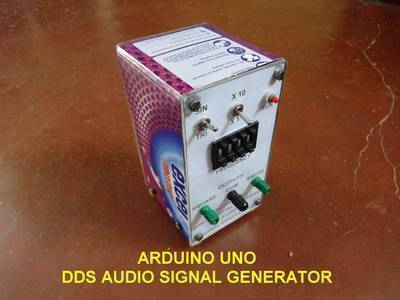
Arduino Uno DDS Audio Signal Generator
"It is motivated by comments from members AhmedS419 and BeenThereD where we discussed the possibility of creating a stand-alone mode without the need for commands from a USB connected PC and GUI. In this Instructable I have modified the hardware and embedded software to provide both an independent stand-alone mode of operation, requiring only external power, and a PC connected GUI mode providing additional features. The project is now enclosed an a DIY Box. Why DDS? A basic Direct-Digital-Synthesis waveform generator outputs the amplitude corresponding to phase-values based on a phase_accumulator which is incremented by a phase_step at a frequency f_clock. Compared to other Waveform Generators using the Arduino uno which directly output amplitude values based on a time-step using a timer interrupt at 100 kHz the current design permits a f_clock of ~400 kHz. Based on requiring at-least 8 sample points per waveform-cycle the effective usable output frequency would then be f_clock/8 or 50 kHz, compared to 100 kHz/8 or 12.5 kHz. Additionally the DDS methodology provides a frequency-increment/setting-resolution for a 24 bit phase_accumulator of f_clock/2^24 or 0.024 Hz." [...]
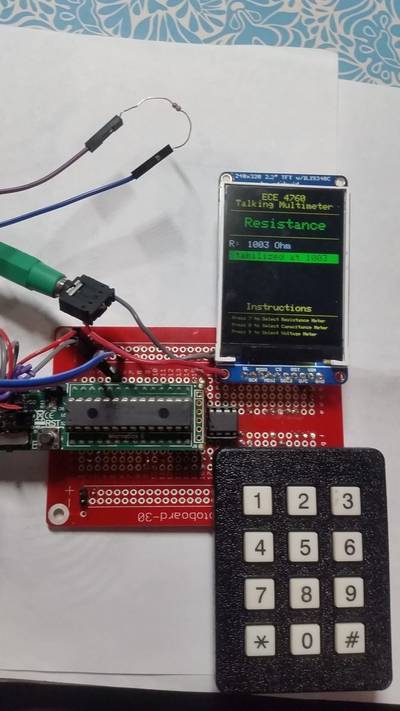
Talking Multimeter
"The talking multimeter uses the PIC32MX250F128B as a voltmeter, ohmeter, and capacitance meter that speaks the reading as it is measured. Spoken measurements improve the usability of measurement devices since the user will be able to focus on the circuit in question and still obtain measurements. The speaking measurement system will provides an auditory alternative to a visual meter. Our system consists of a TFT LCD to display the reading, a keypad to read user input about the mode of the system, and speakers to hear the readings of both the keypad and the measurements. Key presses on the keyboard determine if the multimeter is used a voltmeter, an ohmeter, or a capacitance meter. Additional circuitry and the functionality on the PIC32MX250F128B is used to map the voltages to ranges acceptable for the MCU and to calculate the parameter values. Capacitance values can be measured between 1pF and 100nF. Resistance values can be measured between 0 and 50kΩ. Voltage values can be measured up to 10V and mapped down appropriately for the MCU using a voltage divider." [...]
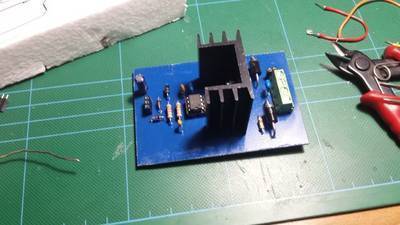
NE 555 Motor Speed Control
"A friend of mine asked me to make for him a simple regulator for his slider camera, that looks like the Revolve Camera's control box. So I find an old Italian magazine called "Nuova Elettronica" where there is a simple schematic that you can order. Unfortunately, the magazine no longer exists. So I have decided to replicate the PCB, also in the case someone will want to use this project for other uses." [...]
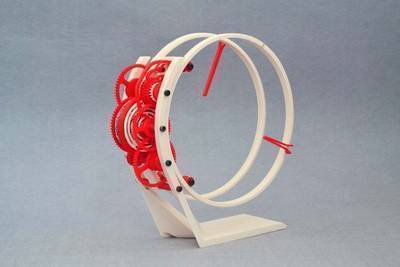
TORLO - a 3d printed electromechanical clock
"The torlo was born out of the idea of using a simple oscillating motor as a power source. The Voice coil of a scarp laptop HDD fit the bill nicely. The Voice coil with its powerful magnets has enough brunt to push a bunch of 3d printed gears .The basic idea of the torlo was adapted from the previous holo clock and taken further. The gears of the clock hang to one side and the rings to the other side of the frame. The voice coil is located in the center of the drive train and is driven by an attiny pulsing it every 2 seconds. The balance wheel when pulsed pushes a cam and a ratchet to turn the clock 2 seconds further. Rest of the clock is a simple drive train driving the minute and hour rings which display the time.." [...]
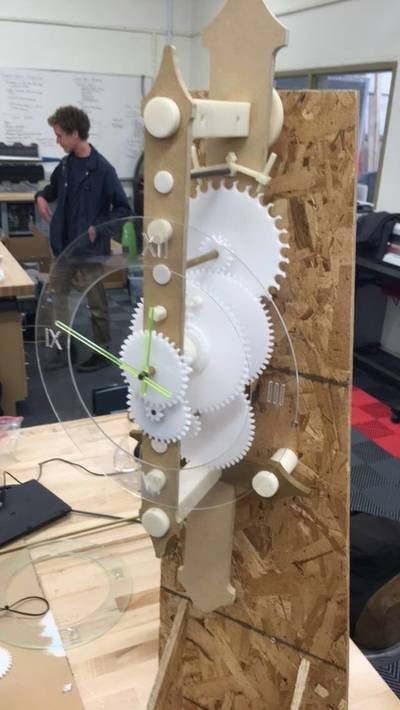
Acrylic Gravity Powered Clock
"We made a gravity-powered, acrylic clock with a minute and hour hand. This is achieved by utilizing two heavy weights and a pendulum that allows the clock to “tick” once a second. The pendulum must not slow down or else the clock would stop moving, so in order to keep the clock in perpetual motion, a mechanism called an escapement is used to “nudge” the pendulum as it swings to keep it in motion. The force behind this “nudge” comes from the hanging mass, which converts its gravitational force into rotational torque that powers the escapement. The pendulum’s oscillation is then converted into rotational speed that moves a gear train at the new, precise speed created by the escapement. Once the gear achieves one rotation per sixty minutes, a rod attached to the gear’s center carries the rotation to the minute hand of the clock. Then, gears interlocking with the minute hand convert the rotational speed from one rotation every hour, to one rotation every twelve hours, giving us the correct timing for the hour hand. A cylindrical, brass sleeve is placed around the rod attached to the minute hand, which allows the hour hand to rotate independently of the minute hand, while still on the same axis. The frame of the clock is made of wood that was cut using a CNC machine, the more complex parts were 3D printed, and all of the gears were laser cut from acrylic sheets. Once all of the parts were modeled on solidworks and an assembly was made, all the parts were produced and assembled in the shop." [...]

Open Source, Connected Robot Arm
"It’s an Open Source and printable manipulator with five degrees of freedom. Which was designed and created by MMH_Team. The main purpose of this project was to create a robotic arm that could be made by makers around the world or in schools to teach robotics instead of using simulation software. In its upright position, hRobot is about 700mm long and it can lift objects up to 500 grams. While development we had many ideas in our minds like: the final prototype had to be Open Source; possible to made mostly by 3D printer; enough powerful to manipulate 500 grams objects; and powered by ROS. We hope that you will enjoy our work :)" [...]

IoT Smoke Alarm with Arduino, ESP8266, and a Gas Sensor
"In this project, we are going to make an IoT smoke detection system in which the MQ-2 smoke sensor will sense if there is smoke nearby. If smoke is nearby, then the buzzer will start beeping and the red LED will light up and a warning will be displayed on a web page which we will create using the ESP8266 module. This web page will be accessible using any connected device like a mobile, tablet, or PC." [...]

Play music with your Remote
"Choose a song with your remote and Arduino will play it. On the monitor will appear the musical note played. " [...]
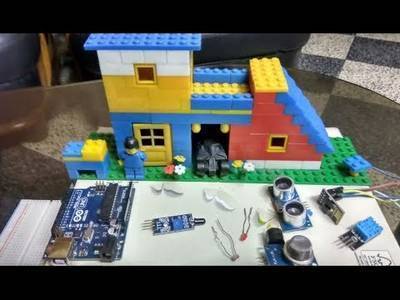
Full Home Automation With E-Mail Notifications Using Arduino,ESP8266 & Python
"This is a full home automation project implemented on this architecture house using the Arduino Uno,ESP8266 and different sensor with E-Mail notifications using python. You can use the 3g-GSM/GPRS module for SMS notifications but this is the cheapest solution. The logic and the process by which this project has been built doesn't have much difference with respect to the real world or the industry. All the codes are there and have been shared step by step." [...]
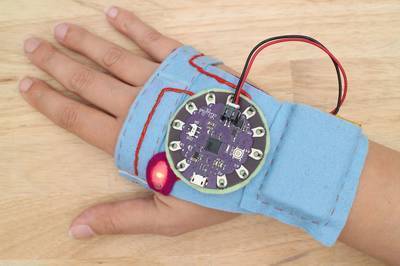
High Five Collector
"In this basic wearables project, you will build a circuit to collect high fives. The final circuit is a simple one you can learn to build in my free Instructables Wearable Electronics Class (Digital Input and Digital Output lessons)." [...]
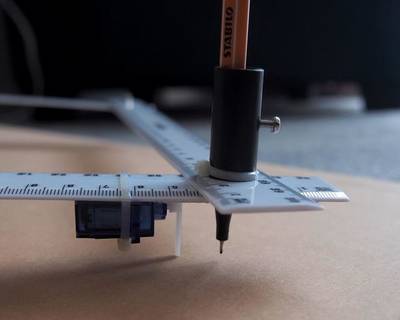
CNC Dual Arm Plotter
"This instructable describes an A4 plotter made from four plastic rulers , two NEMA17 stepping motors, and an SG90 servo pen-lift. The plotting area may be scaled to any size by increasing the length of each arm. The plotter has an on-board interpreter that recognizes the g-code output from "Inkscape". Construction is simple. All you need is a wood saw, three twist drills, a screw-driver, a "rat-tail" file, and a soldering iron. While the software only supports point-to-point plotting, the plotter resolution and accuracy is more than sufficient for its intended purpose of creating water-color outlines." [...]

THIRD EYE FOR BLINDS - an Innovative Wearable Technology for Blinds
"Third eye for blinds is an innovation which helps the blinds people to navigate with speed and confidence by detecting the nearby obstacles using the help of ultrasonic waves and notify them with buzzer sound or vibration. They only need to wear this device as a band or cloth. According to WHO 39 million peoples are estimated as blinds worldwide. They are suffering a lot of harder ship in there daily life.The affected ones have been using the traditional white cane for many years which although being effective, still has a lot of disadvantages. Another way is, having a pet animal such as a dog, but it is really expensive. So the aim of the project is to develop a cheap and more efficient way to help visually impaired to navigate with greater comfort, speed and confidence." [...]

How to Make a IoT Pet Feeder
"Use circuito.io to build a smart food dispenser for your pet controlled directly from your phone." [...]

Simple Infinity Cube
"I know there are lots of infinity gizmos out there - so here is another!. I found it easy to make and it usually gets a good "Wow!" I assume that anyone making theses has basic skills (mine are pretty basic!) In the basic form of the infinity mirror you place an LED between a mirror and a half mirror to produce the infinity effect, in this version you have a mirror box - an LED and a larger half mirror box on the outside. the LED is in a strip that can be any shape and produce many effects, the two I show here are the corner strip and the tube strip.the boxes are made on a laser cutter using the Box-designer or other such app." [...]

Digital Tachometer
"This is a Digital Tachometer using Hall Effect Magnetic Sensor, Arduino Nano and show the result on 4 Digit 7 Segment Display. Its very simple project to build. As you see on circuit diagram, we only need 4 resistors to limit the current for the 7 segment display." [...]

How to Make 5 Volt Single Channel Relay Shield for Arduino, PIC, AVR
"In this tutorial i will show you how to make a 5 Volt Single Channel Relay Shield For Arduino, PIC, AVR." [...]

Individually Addressable Incandescent Lamps
"Everyone playing with electronics these days knows about LED strips made of dozens or hundreds of individually addressable RGB LEDs. I love them and make great use of them in the nootropic design Lumazoid music visualizer. But what about incandescent lamps? Old-school light bulbs with a filament have a soft warm glow that you just can’t get from LEDs. Wouldn’t it be great to be able to control a bunch of lamps individually by setting their brightness in code on a microcontroller? This is just what I set out to do recently, and the results are great." [...]
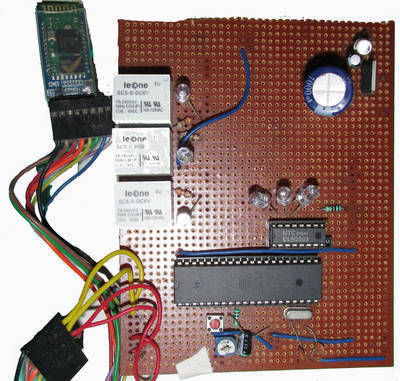
DIY Cheapest Bluetooth Controlled Home Automation
"The basic is very simple... You need a bluetooth enable host device i.e. mobile,computer or anything!! For the sending of command to the circuit. We have used a bluetooth module(HC-05 "HANDS & LEGS OF THE CIRCUIT" ) for catching the signal from paired host device and relaying the same to the microcontroller through its Tx pin to TxD of the later. But you can also use HC-06/07, Sable-x-R2, TIWI-uB1 etc. Now comes the microcontroller..."HEART & BARIN OF THE CIRCUIT"... receives data from bluetooth module and does the work according to the code written in it and REPLIES to the bluetooth module.(TxD to Rx) Pins of microcontroller gives output and thus connected pins of ULN2003 receives it and gives 0V(initially 5V) making the relay trip(work). Relay's one leg connected to 5V(OR 6V) and another leg get 5V or 0V depending on ULN2003 output. When potential difference(voltage) across relay is 6V it works for 0-3V it doesn't work." [...]

Arduino Plant Watering System
"This Instructable will explain how to make a plant watering system powered by Arduino. Each of the components is specified with a link to where they can be purchased online. The process of making the system will be detailed step-by-step from the hardware to the code." [...]
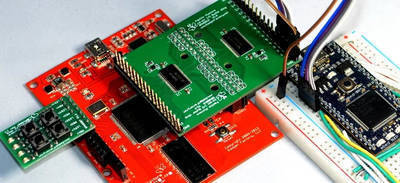
Getting Started with FPGAs: Lookup Tables and Flip-Flops
"Just what makes an FPGA so different from a microcontroller and yet so versatile? This article continues the exploration of FPGAs, focusing on the role of flip-flops and lookup tables (LUTs) in logic blocks. The fundamental building blocks inside of an FPGA are the flip-flop and the lookup table (LUT). These are combined to form what are referred to as logic blocks. The logic blocks connect to each other, and the outside world, through programmable interconnects. The flip-flops operate more or less like any flip-flop you may have stumbled upon over the years. LUTs, on the other hand, aren’t quite as universal a concept." [...]
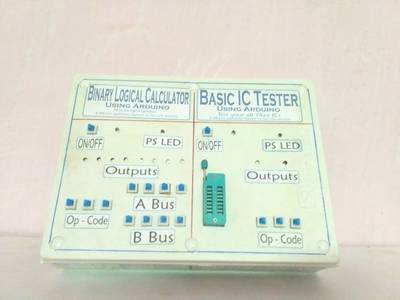
BLC Using Arduino Emulator
"What is this BLC? Ans: Binary logical Calculator using Arduino Uno R3. Formally we are doing Arduino project which is real-time application in introductory labs and other places. This is all about how to create Arduino Uno project which does some basic computation for our regular labs and homeworks. Again with new concept and new topics hitting to my mind, So today I did one more project using Proteus V7 and Arduino IDE. Let's start .......! This is one of the simple design as concerned to circuits and product. But in case of Coding it it quite complex. Now what I'm going to share with you is, All about the procedure that I used to do this. Hope you Like it." [...]
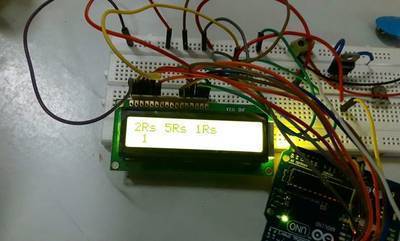
Coin spliter and counter
"Nowadays automation plays a major role in every field which reduces manpower and increases efficiency. This project deals with the separating of coins and currency and counting the total amount of coins. More number of Indian temples has donation boxes. Separation and calculation of currency and coins that are inserted into the donation boxes need more human intervention. Nowadays these processes completely depends on human hands. It requires more time and man power to separate and to calculate coins and currency. This project adapts automation for this time-taking process. Thus making the process more fast and accurate." [...]

Smart Irrigation System Using IoT
"The Smart Irrigation System is an IoT based device which is capable of automating the irrigation process by analyzing the moisture of soil and the climate condition (like raining).Also the data of sensors will be displayed in graphical form on BOLT cloud page. For detailed description of project click on the Research Paper link given below- http://dx.doi.org/10.17577/IJERTV6IS060067 In this project, we will command the arduino/328p microcontroller through a webpage to control the motor (i.e., to start and stop the motor) and the rest of whole irrigation process will be automatically controlled by arduino itself. The user has only to do is –Start the motor or if he desires it can switch off the motor by just a click only. Once the Motor pump has started- following automated condition will work: User can switch OFF the motor if he desires by a click on the web page; The motor pump will automatically get switched OFF once the soil moisture sensor has reached the required threshold value; If weather condition is such that it started raining, then the micro-controller will shut down the motor pump till raining. And after that it checks whether the soil moisture sensor has reached the threshold value or not. If it crosses the threshold value then motor pump will remain shut down otherwise it will start again automatically. This helps in saving water resource and electricity; Also in case, when power supply gets cut-off and motor gets switched off. It will restart again automatically when there will be availability power supply, user will have not to worry about restarting the motor pump manually; Also data of various sensor like- moisture sensor , temperature sensor, humidity sensor will be displayed on BOLT cloud in graphical form but due to limitation of BOLT i have only displayed one sensor data(moisture sensor data)." [...]

Retro Nokia Snake Game with Arduino
"Super Mario, Tetris, Pac-Man - don't you wish you could go back in time to enjoy sitting hours in front of a black screen with minimal resolution and play these wonderful and so-addictive games? Well, after we added the Nokia screen to circuito.io, this build was inevitable. We are proud to present our latest creation - the Nokia Snake game wrapped in an Arduino box!" [...]
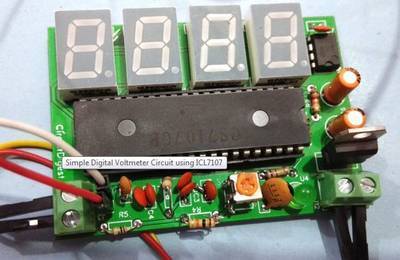
Simple Digital Voltmeter Circuit With PCB Using ICL7107
"In this project we have a tendency to design a circuit to build an electronic voltmeter while not making use of any microcontroller. Here we have a tendency to employing a very moderate IC for voltage activity particularly ICL7107/CS7107. Making use of ICL7107, we are able to build correct and really low price digital voltage measurement meter. ICL7107 may be a 3.5 digit analog to digital device (ADC) that consumes extremely low power. The IC has internal circuit for driving four seven section show to show the measured voltage. It additionally encompasses a clock circuit and a reference voltage supply." [...]
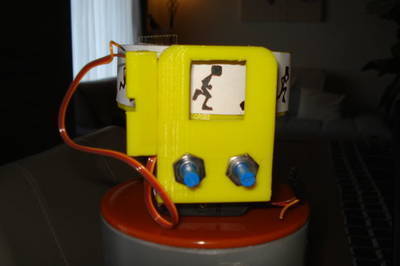
Mini Zoetrope
"This is one of my favorite projects "Creating Movable Images". I have chosen a mini zoetrope because I want to use an A3 sheet format. The dimensions of an A3 blade are 29.7 to 21 cm. I use the diameter of the drum the length of an A3 size = 29.7 cm = diameter 92.30 mm = radius 46.15 mm The height of the drum is 30mm. Als Servo gebruik een gewijzigde mini 9g servo Als potmeter gebruik ik een van 10K Als led gebruik ik 3 leds in parallel met een weerstand van 100 ohm in serie met een 4,5 volt battery voeding. I have to admit that I need to find a better place for the leds, but I could not wait to share this project with everyone. The holes in the drum have I done to save some material and time in 3D printing. At the bottom of the zooprop is a battery box of 3x 1.5v AA batteries" [...]
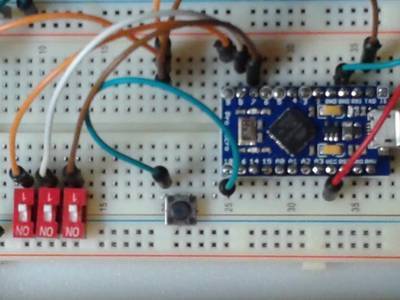
RPi Serial Console Automation using Arduino
"In a recent article I showed how an Arduino Pro Micro can be utilized to send characters to the serial console of the Raspberry Pi Zero W. The Pro Micro was chosen because it is small, inexpensive, and easily acquired plus the integrated USB port provides a convenient way to easily upgrade the programming. (Always disconnect the ProMicro Vcc from the RPi before inserting the USB micro cable into the Pro Micro.) This article will maintain all of the assumptions from the previously referenced article and will concentrate on the Arduino programming side by showing how easily multiple digital pins can be used in tandem to create a numeric value and then that numeric value can be used to call various functions to perform our requirements using just a single pushbutton to initiate communications with the RPi over the serial console." [...]

Arduino temperature Logger with SD card
"We developed this outdoor stable temperature logger ourselves and programmed it in cooperation with Dominikus Pfeiffer. We use this to record the ambient temperature for our small weather station in North Berlin, Germany. You can also use it in cold rooms or in the apartment to analyze purposes. Thanks to Windows and Macintosh Excel / Numbers tables you can create wonderful graphics and evaluate the data. The temperature data stored every 15 minutes on a Micro SD card in a TXT file is evaluated every few months as required. Since we do not have to often to the memory card, we have this safe from moisture in the Inside. The housing is enclosed with 8x M2 screws and nuts. The power cable can be led outwards through a large hole in the ground. The smaller extinguishers are used for attachment to the site. Furthermore, the current temperature is displayed via a segment display, or the last one has been stored on the SD card. A modern DS18B20 sensor serves as a temperature sensor and stores the values precisely to 0.5 degrees Celsius. A yellow LED only shows that the device is on the current, so you can see from the distance it works, it flashes every few seconds. The other two LEDs are only visible when writing the data on the SD card and when the time is being requested, because, among other things, a real time clock is installed. Each restart causes a new TXT to be created, consecutively numbered." [...]

ESP8266 Based Temperature Sensor Connected to Home Assistant and MQTT
"In this instructable I will show you how to make room sensor to monitor temperature and humidity and with an additional sensor to monitor water temperature in an aquarium. We will then set it up to work with Home assistant through MQTT" [...]

This Custom Built “Commute Deck” Makes it Easy to Work on the Go
"Two years ago, I quickly discovered that using a laptop on the train was pretty uncomfortable when I started a new job that was 1.5 hours away. Either the screen was fully open but the laptop was jammed into my stomach, or I could type comfortably but the screen was half shut. I decided the best solution to this inconvenience was to build my own portable computer from scratch. I call the final product the Commute Deck. The Commute Deck is designed to provide a productive computing experience for UNIX terminal work in tight places, like the train or an economy seat on an airplane. It can be carried by hand or hooked onto a bag. It is robust enough to be jostled, and sealed so it can be carried outside in uncontrolled conditions. The mechanical keyboard is comfortable to type on (in width and layout), and the battery life is sufficient for a cross country flight or a full day at a conference. The theme of this build is to identify the problem you want to solve, then solve that problem. Seems like a tautology, but I find it’s easy to waste time solving problems that don’t really matter. There are a number of areas where I traded elegance for off the shelf components to reduce complexity, cost, and time to completion." [...]
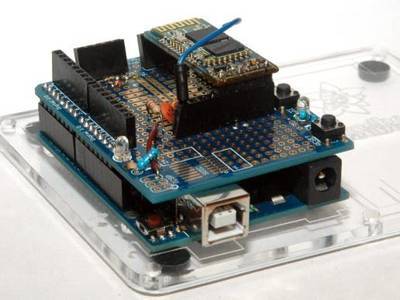
Arduino Bluetooth Programming Shield
"This project will show you how to make a wireless upload Arduino code from your Computer via Bluetooth." [...]
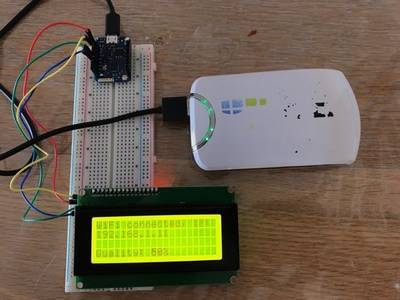
Arduino WIFI Quality signal display
"I was wandering who my WIFI signal spread across my home. So I build a device that display the signal strength using arduino+wifi and LCD display." [...]
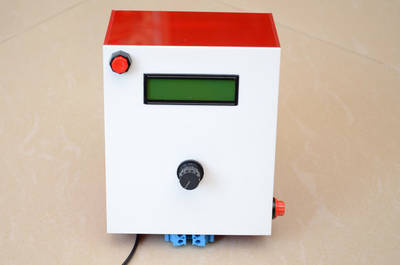
Garden Sprinkler Controller
"This is my second instructable which is actually a modified version of "versatile on/off timer"(My first instructable) with some added functionalities such as A digital real time clock display, Active Window setting, Loading of default values when idle after power on. This time I am calling it a "Sprinkler Controller" as it is used to control the sprinklers in the personal garden. " [...]
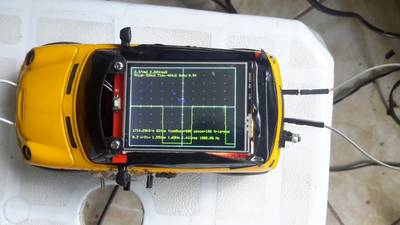
multiScope
"Fast, Portable and Affordable Oscilloscope and Inductance Meter. Don't be deceived by its small size. This little beast has an inductance meter and a oscilloscope with sampling rate of 1.7 MS/s, based on a STM32 running at 72MHz. Frequency, voltage and duty cycle information are included. As a bonus, you get temperature and pressure sensing. The main goal when I built this was to have a simple to use yet capable scope to view oscillations and an inductance meter to learn about oscillator circuits. Commercial versions of these tools have a high price that is prohibitive to many of us, so the more affordable and open source approach of this project may allow more and more makers and hackers to explore this wonderful part of electronics. Building our multiScope isn't hard from the hardware perspective, it is in the software that most magic happens. The base of this project was the STM32-O-Scope (which is also based on another scope), from which I got the DMA code. Without it, our scope wouldn't be so fast. The STM32F103C8T6 is a 32bit ARM microcontroller (with a quite long name) that has higher clock and ADC resolution than any AVR based Arduino, but is still cheaper than them. Another great thing is that you may program it using the good old Arduino IDE. I've chosen a touch screen dispay for multiScope to keep user interaction simple and flexible. With these same principles in mind, the input signal is connected to a voltage divider that can be replaced in order to reduce voltage to 3.3V, the maximum value STM32 will safely handle. Our inductance meter is based on LM339 and a simple LC circuit whose resonant frequency we measure to get the unknown L value. You may adapt multiScope to your needs. As I had a bmp180 lying around, it was included as an extra feature, but it's your choice. If you don't want it or want to include another kind of sensor, just change a few lines of code." [...]
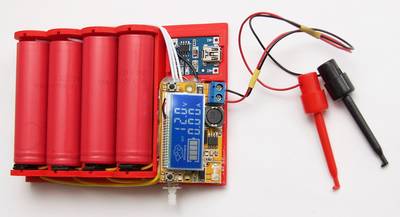
Quad 18650 power supply
"This is a little portable power supply I made a while back, with four very common type-18650 cells (widely available from eBay, despite today’s air shipment regulations)." [...]
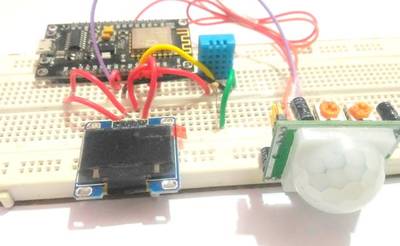
Nodemcu With OLED Display, PIR & DHT11
"In this project we are going to build a system which shows temperature and the motion on oled display. The project is easy to build and implement." [...]
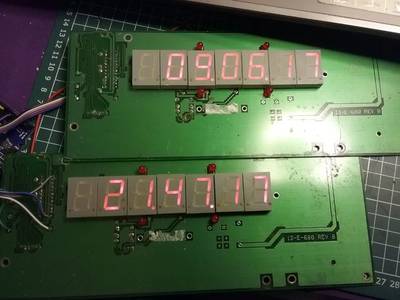
7 Segment Date & Time With BT Adjustment
"I rescued some old weigh indicator boards from scrap heap! I already had a DS3231 rtc & a HC-05 BT module, so I decided to make use of the rescued boards. I have yet to put them in a posh box - I'm working on that one! I have not yet decided whether to have this battery or mains powered, but if I choose the battery route, I am considering using a proximity or movement sensor to turn on the Led display for a minute or two, and then timeout to save power." [...]
That's all Folks!


